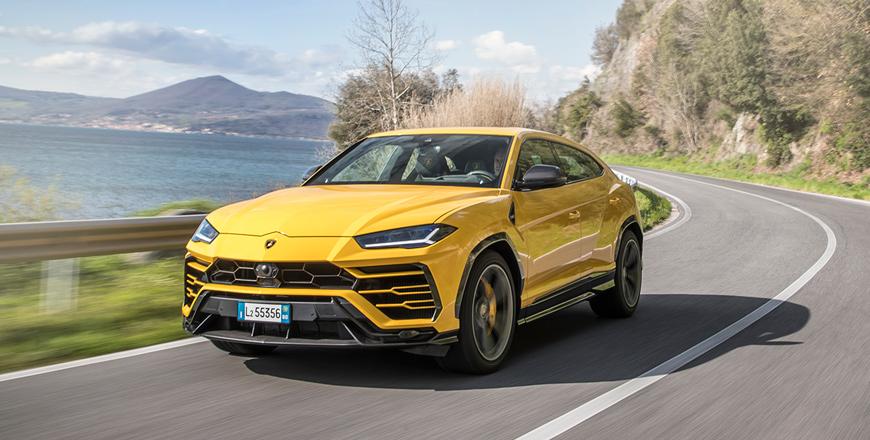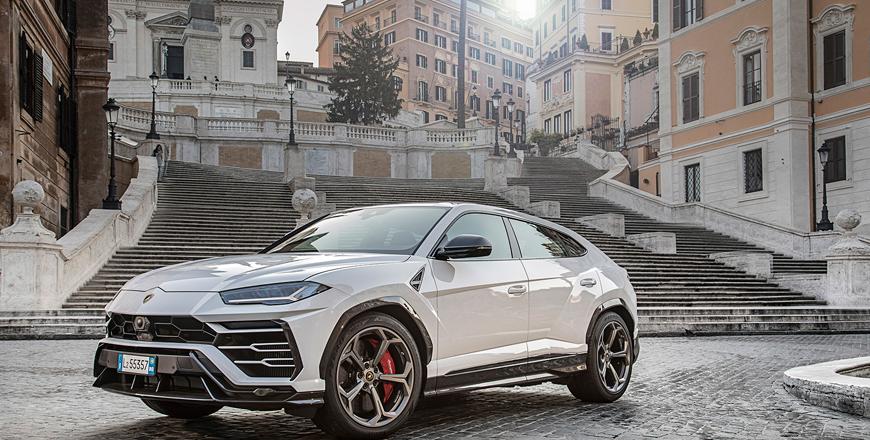You are here
Lamborghini Urus: Return of the Rambo Lambo
By Ghaith Madadha - Jun 15,2020 - Last updated at Jun 15,2020

Photo courtesy of Lamborghini
The Italian supercar maker’s inevitable return to the now highly lucrative SUV segment, the Lamborghini Urus may be a different sort of animal than its predecessor, but is not quite the break with tradition that SUV making is for other car makers grounded in the luxury and sports niches. Best known for virtually inventing the modern supercar back in the 1960s with the mid-engine Miura, and for defining the perception of what a supercar looks like in the form of the 1970s Countach, Lamborghini’s latest foray into the SUV market can arguably be viewed as a return to its roots.
Originally a tractor manufacturer that diversified to luxury coupes, sports and super cars due to grudge between founder Ferrucio Lamborghini and Enzo Ferrari, the Sant’Agata based manufacturer’s original SUV was the iconic and extreme Lamborghini LM002, circa 1986-93. Unofficially dubbed the Rambo Lambo for its enormous, chunky and aggressive design as much as for its Countach-sourced V12 engine and quasi-military origins, the brutal LM002 became a cult favourite among a certain strata of the ultra wealthy and powerful. Arriving in 2018, its Urus successor is, however, an altogether different beast, built for practicality, prestige and supercar-like speed and handling.
A different breed of beast
Built on a car-like unibody platform shared in basic form with wider Volkwagen group SUVs including the Bentley Bentayga, Porsche Cayenne, Audi Q8 and Volkswagen Touareg, the Urus’ design, however, owes little to its relations. Angular, jutting and sharply aggressive in its lines and demeanour, the Urus may share similar Countach-derived hexagonal wheel-arches with the LM002, but instead disguises its size, and is otherwise more congruent with Lamborghini’s current supercar design themes and details, from its high waistline, low coupe-like single line silhouette, accented diagonal hood lines and bonnet mound, and dramatically slim headlights and sharp supercar-like snout.
Fed through tall SUV-high slatted intakes aside its slim grille that visually indicate its size, the Urus engine is a twin-turbocharged 4-litre V8 positioned in front, unlike other Lamborghinis’ naturally-aspirated and mid-engine V10 and V12 propulsion. Significantly reworked and more powerful than in Audi and Bentley derivatives of the same basic unit, the Urus’ engine develops an enormous 641BHP at 6,000rpm and 627lb/ft torque throughout a broad and versatile 2,250-4,500rpm range. Driving all four wheels with vice-like traction, it powers the near 2.2-tonne Urus through 0-100km/h in just 3.6-seconds, through 0-200km/h in 12.8-seconds and onto a 305km/h top speed.
Buttoned down brute
Even more impressive than the Urus’ headline performance stats and its comparatively moderate 12.3l/100km combined fuel economy is it driving characteristics. Hugely powerful and willing to rev higher than most turbo engines — until 6,800rpm — the Urus’ responses are sharp and crisp, if not quite as razor-edge responsive as Lamborghini’s Huracana and Aventador supercars. Launching brutally with very little by way of turbo lag, the Urus pulls hard and swells with to an immense mid-range torque sweet spot. Effortlessly immediate when overtaking or charging up steep inclines, the Urus’ broad torque band is complemented by ferociously urgent power accumulation.
Relaxed, smooth and civil when driven in its default Strada mode, the Urus’ driving parameters and responses sharpen up in its more aggressive Sport and Corsa modes, with a stiffer ride, enhanced throttle control and quicker, more aggressive cog shifts through its slick and quick 8-speed automatic gearbox. Sending power to all four wheels with a 60 per cent rear bias under normal conditions, the Urus’ centre Torsen differential can divert up to 85 per cent to the rear or 70 per cent to the front, as necessary for flawlessly reassuring road-holding. Meanwhile, a torque vectoring rear differential distributes power from side to side for enhanced agility.
Hill climb hero
A smooth, refined and reassuringly stable high speed cruiser with decent ride comfort despite its giant alloy wheels, the Urus is distinctly softer edged next to other Lamborghinis, but is a focused supercar compared to most SUVs. Designed for daily practicality and exceptional sporting ability, the Urus fulfils both roles, utilising adaptive air dampers, adjustable ride height and sublimely effective active electromechanical anti-roll bars to achieve its Jekyll and Hyde balancing act. With its active suspension firming up to keep it buttoned down with excellent lateral roll control through corners, and particularly focused in Corse mode, the Urus proved to be a phenomenal hill climb hero.
Taut, grippy and precise through corners, the Urus drives through winding climbs like it is following fixed rails. Direct, crisp and eager tucking into a corner with its quick 2.29-turn steering, flat throughout and tenaciously digging into the tarmac on the way out, it is, however, the Urus’ four-wheel-steering which was possibly its most impressive dynamic feature. With rear wheels turning in the same direction as the front wheels to effectively elongate its wheelbase by 600mm for added stability and footing, the Urus can meanwhile simulate a 600mm shorter wheelbase when the rear wheels turn in the opposite direction at lower speed for an unexpectedly high level of cornering agility.
Reconciling Jekyll
and Hyde
Scything through successive corners, bends and hairpins with weight- and size-belying agility and control, the Urus meanwhile well-absorbs road imperfections, even if riding on the firmer side, and feels settled over dips and crests. Inside, its carbon-fibre and Alcantara-swathed cabin seats five and provides a hunkered down well-adjustable and supportive driving position with good front visibility. Layouts and controls are similar to Lamborghini’s supercars and include a starter button with a trigger-safety cover, while its combination of push button and steering-mounted paddle shift gear selectors aren’t immediately intuitive, but quickly become second nature.
Winner of the 2020 Middle East Car of the Year’s best Premium Performance SUV award, the Urus is extensively well-equipped with safety, driver-assistance, infotainment and convenience features, and includes a reversing camera and sensors to help make manoeuvring easy despite its high sides and low roofline, while an auto opening tailgate helps access its 616-litre boot. The most practical Lamborghini and very spacious as a supercar, the Urus’ rear seat space and access is good for most, but a sporty low roofline means it is not the most generous for tall passengers if compared to some more traditional SUVs.
TECHNICAL SPECIFICATIONS
Engine: 4-litre, twin turbocharged, in-line V8-cylinders
Bore x stroke: 84.5 x 89mm
Valve-train: 32-valve, DOHC, direct injection
Rev limit; 6,800rpm
Gearbox: 8-speed automatic, four-wheel-drive
Drive-line: integrated front, Torsen centre and torque vectoring rear differentials
Power distribution, F/R: 40 per cent/60 per cent (default)
Power, BHP (PS) [kW]: 641 (650) [478] @6,000rpm
Specific power: 160.4BHP/litre
Power-to-weight: 291.7BHP/tonne
Torque, lb/ft (Nm): 627 (850) @2,250-4,500rpm
Specific torque: 156.9Nm/litre
Torque-to-weight: 386.9Nm/tonne
0-100km/h: 3.6-seconds
0-200km/h: 12.8-seconds
Top speed: 305km/h
Fuel consumption, extra-urban/urban/combined: 9.7-/16.7-/12.3-litres/100km
CO2 emissions, combined: 279g/km
Fuel capacity: 85-litres
Length: 5,112mm
Width: 2,016mm
Height: 1,638mm
Wheelbase: 3,003mm
Track, F/R: 1,695/1,710mm
Ground clearance: 158-248mm
Luggage volume, min/max: 616-/1,596-litres
Kerb weight: 2,197kg
Steering: Electric-assisted rack & pinion, four-wheel-steering
Steering ratio: 13.3:1
Lock-to-lock: 2.29-turns
Turning Circle: 11.8-metres
Suspension: Multi-link, adaptive air dampers, active electromechanical anti-roll bars
Brakes, F/R: Carbon ceramic ventilated discs, 440 x 40mm/370 x 30mm
Brake callipers, F/R: 10-/6-piston
Braking distance 100-0km/h: 33.7-metres
Tyres, F/R: 285/40R22/325/35R22 (as tested)
Related Articles
Purveyors of extreme machines almost from the outset, Lamborghini could credibly be credited with defining both the modern supercar’s mid-en
Historically playing second fiddle to Lamborghini’s glamorous V12 supercars, the Italian carmaker’s 1972-88 Urraco, Silhouette and Jal
With theatrically aggressive designs, viciously powerful engines and albeit unintended boxing associations, Lamborghini is automotive machismo distilled.



















